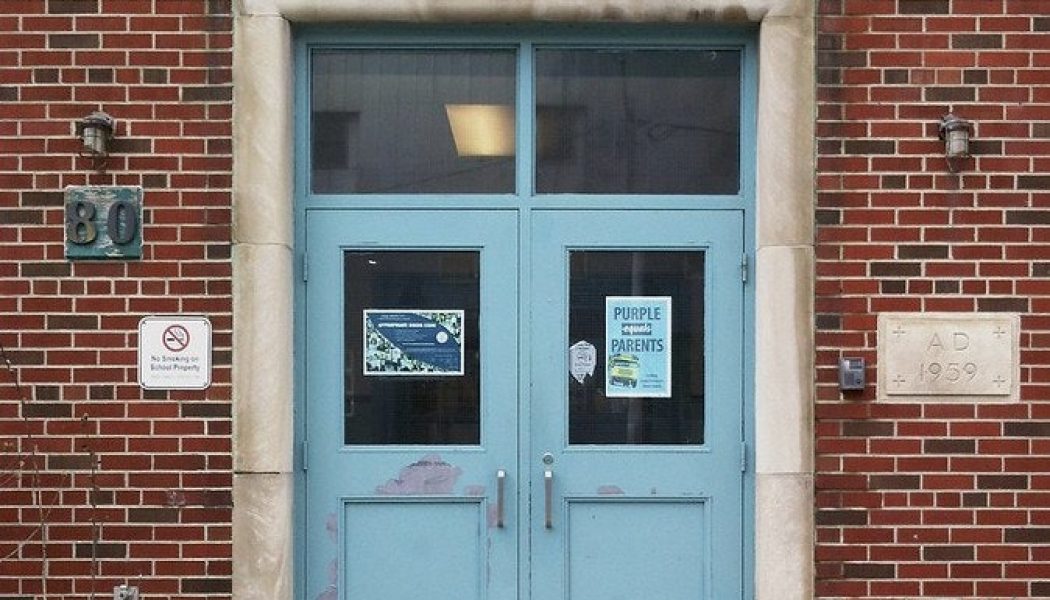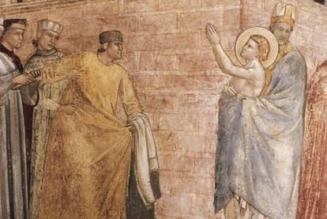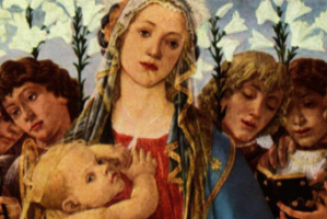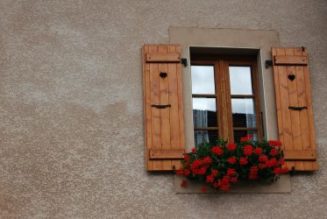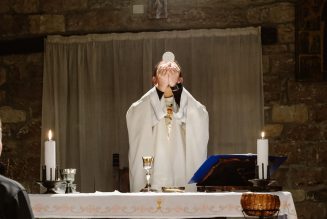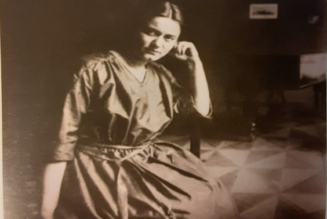A sharp drop in the number of preschoolers attending Catholic school is behind the largest single-year decline in enrollment in 50 years.
The U.S. Catholic school population has been declining for decades, and the pace of that decline was accelerating even before the pandemic began. The pandemic has sharpened declines, but some Catholic leaders see in the crisis a chance to sharpen and showcase the unique offerings of Catholic schools.
A report due to be released Feb. 17 by the National Catholic Educational Association shows that 1,626,291 students are enrolled in Catholic schools in 2021, a decline of more than 111,000 from 2020. The sharpest drop-off came in Catholic preschools, which enrolled 44,000 fewer students in 2021 than they did in 2020.
Between 2010 and 2020, Catholic schools lost an average 38,204 of students per year. But the NCEA data suggests the pace of attrition has sped up over the last decade— between 2019 and 2020, Catholic schools lost 52,066 students.
The pandemic has hastened the decline. Even if preschoolers were not counted, 66,000 fewer students were enrolled in Catholic schools in 2021 than in 2020.
John Schwob, director of pastoral planning in the Archdiocese of St. Louis, told The Pillar he believes 2021 declines in enrollment are temporary in his archdiocese.
Schwob told The Pillar he is the “numbers guy” in the Archdiocese in St. Louis, and spends time looking at demographic trends in the area.
When he saw that local preschool enrollment had dropped off, he was “not at all concerned about it. Some of it may be economic, if the family has lost an income, but I think it’s more because the family is working from home. And that’s not the same as an educational environment, but this is a strange time. This whole covid thing is unprecedented.”
Schwob said he expects enrollment numbers won’t be affected in the long-term by a preschool drop-off. Parents choose Catholic preschools for different reasons than they enroll their children in elementary school, he said, and preschool enrollment isn’t predictive of enrollment in Catholic kindergarten.
“I fully expect a bounce-back. I just think this is a unique year.”
Catholic schools in the St. Louis archdiocese may have been given a unique opportunity in 2021, Schwob said, one that could help stem the tide of “modest” annual decreases in enrollment.
“Most of our public schools in St. Louis were virtual, so many had parents trying to enroll their kids in our Catholic schools,” he said, adding that Catholic schools hadn’t been able to accommodate entirely a surge of demand for enrollment from parents who wanted an in-person education for their kids, and many had created waiting lists.
Schwob hopes some new families will remain at Catholic schools even as local public schools resume in-person learning.
“I hope that our Catholic schools were on their A-game when they had those public school kids in their classrooms. We want those families to say ‘this was a great experience and it’s worth the investment to send them back next year. That’s what we’re all hoping.”
Waiting lists at Catholic schools have jumped by 10% in the last year, suggesting to some that some students will return after the pandemic. But the NCEA has said it is not sure what to expect as in-person learning resumes.
Whatever the short-term prospects, Mary Pat Donoghue, executive director of the education secretariat at the U.S. bishops’ conference, told The Pillar that the coronavirus pandemic gave Catholic schools, parishes, and families a reset on their approaches to education. Families were especially impacted, she said.
“This crisis has made it abundantly clear to parents that they really are the primary educators of their children. They have to see to it that their children get whatever education is most appropriate for them. In some cases, that really has benefited Catholic schools,” she said, mentioning that some parents have chosen Catholic schools because local public schools have adopted virtual-only models.
“People who may not have ever been attracted are giving this a second look, because there is a lot of respect for Catholic school teachers who are offering in-person instruction,” she added.
Donoghue said the pandemic should also be a moment for introspection about the parish’s role in education. She said parishes have a role in supporting all families in the mission of education, not just families enrolled in a parish school.
“It’s the idea of the parish saying, ‘We want to support you families in how best to educate your kids.’ And I think we need to restore that principle, that we’re here to support families. Some of them will choose to homeschool [or send children to public school]. Schools and parishes should be supportive of that.”
While parishes focus on particulars, Catholic schools in the U.S. have broad problems to work out, the NCEA said Wednesday, especially because of changing American demographics.
The NCEA report did not compare declining enrollments with population trends, but in a webinar Wednesday, the NCEA’s Sr. Dale McDonald said that as the U.S. population has shifted southward and westward, Catholic schools in the Northeast have closed more quickly than they’ve been built in other places, leaving schools in one place, and people in another.
Donoghue agreed.
“We do have a problem, because we have a lot of infrastructure and not a lot of students in the Northeast, and we have a burgeoning need in the Southwest, and not a lot of infrastructure. Especially as we think about how to serve the Latino population, and students who are immigrants themselves. There is need and opportunity, but we may need to rethink some things — what we did 100 years ago may not be applicable.”
Donoghue also mentioned the challenge of increasing religious disaffiliation among American Catholics, which is expected to be accelerated by the closure of parishes during the pandemic.
“It’s more of a long-game concept, but it’s important to actively and consciously form Catholic adults. We have a tendency in education to think of the child, but really what we want to be thinking about is forming the child to one day be an adult in the Church: to be married and raising children, or in consecrated life, or in priesthood, or in a single life serving the Church. We want them to be able to imagine that for themselves and to be able to grow into that.”
“Because we’re suffering badly, for several generations that haven’t done that,” she added.
More than 200 Catholic schools closed between 2020 and 2021 – some to consolidate with neighboring schools. While that number is high, it is only part of a broad trend: roughly 130 Catholic schools have closed annually each year since 2012, the first year for which NCEA data is available.
Donoghue said she hopes parishes and dioceses will “work very hard to maximize the number of kids we can serve at any particular school” before consolidating or closing schools.
A tendency to consolidate schools too quickly doesn’t always work out, she said, so “how can we support a school that may be small or struggling? Is it possible, can we do it with an economy of scale to its size?” she asked.
In some dioceses, economizing has meant schools sharing some faculty and staff positions. Donoghue said it can also mean thinking creatively about how to invite students who are homeschooled, or attend public school, to participate in programs and classes offered at the parish school.
Some education experts argue that closing a school too soon can be a lost opportunity.
“We believe that the solution to the crisis in Catholic education has been hiding in plain sight all along. We see that when schools step away from a secular approach, and return to the Church’s true philosophy and practice of education, we see a dramatic transformation,” Elisabeth Sullivan, executive director of the Institute for Catholic Liberal Education, told The Pillar.
NCEA officials have called for a focus on local and marketing campaigns to tout the virtues of Catholic education. McDonald and other NCEA officials also said their organization has work to do to understand why some parents choose charter schools and other private schools over Catholic schools, even in states with school vouchers and other forms of assistance.
But Catholic school enrollment will increase most when schools differentiate themselves by their uniquely Catholic identity, Sullivan said.
Sullivan told The Pillar schools stand out among other options when their identity is clear. A commitment to a uniquely identifiable mission benefits the bottom line, and the viability of struggling Catholic schools, she said.
The Institute for Catholic Liberal Education works with schools to reexamine the Catholicity of education in their schools.
Secular approaches to education “erase the Creator, but also erase mystery and wonder.” That kind of education, she said, leads to bored students and bored teachers.
“The children in our schools are not bored. They are alive, and they are excited to discover. They come to school joyful,” Sullivan said of schools working with the ICLE.
“The world is a different place through the eyes of faith,” she told The Pillar.
Discovering wonder, she said, “drives students to want to know. And that’s a deeply Catholic and highly ordered approach to education.”
“And nobody else has it. Nobody but the Church can unite faith and reason, to give confidence in joy in knowing what the world is and what is our place in it,” she said.
The ICLE’s approach to Catholic education has usually been called “classical,” but some proponents of the approach have tried to move away from that term, which has become a stereotype in some education circles, and criticized as elitist.
Sullivan pushed back on that idea. The Catholic liberal arts approach is a “deeply human education that feeds anyone who has a soul,” she said.
“Why would not every child, of every background, not deserve and need an education in truth, and goodness, and beauty?”
Emphasizing that the approach can transform struggling schools, Sullivan cited the “explosive growth” of several schools that have adopted a liberal arts approach, which she says is rooted in the Church’s teaching on Catholic education.
She mentioned as one example St. Jerome’s Academy in Hyattsville, Maryland. The city is a small, ethnically diverse, urban suburb of Washington, DC.
In 2009, St. Jerome’s was under threat of closure, when parish leaders decided to adopt a liberal arts model of education. It was a “Hail Mary pass,” Sullivan said.
When the school began a transition, there were 264 students. It is now at capacity at 408 students, and has “spawned a high school,” she added.
“We begin with what the Church is teaching about Catholic schools. We want to go back to what the Church says about the human person. About the nature of reality. To what the Church says about pedagogy: that pedagogy has to spark wonder. Because wonder is a hunger for God.”
To address declining enrollment, Sullivan said teachers “need to be fed, spiritually and intellectually. Beautiful, faith-filled people who have invested their lives in Catholic schools need to be invested in. They deserve that investment,” and that leads to a renewal of schools.
“Teachers— it’s an honor to serve teachers. To support them. They’ve made a lot of sacrifices to work in Catholic education.”
Sullivan told The Pillar that Vatican documents on Catholic education have long focused on an integrated approach to faith and reason, a uniquely Catholic worldview, and a perspective that goes beyond the intellect.
“Somebody who is liberally educated is able to see the truth of things. We don’t just want to learn how to earn a living, we want to learn how to live,” she said.
People think of liberal arts as “those dreaded college majors from which your children will emerge without job prospects. But the liberal arts are the architecture for critical thinking. We practice them to sharpen our minds, in order to see the truth of things.”
Earlier this week, Pope Francis lamented an “anthropological crisis” made visible during months of lockdowns, along with economic and social instability. He said Catholic education is key to addressing that crisis.
“We are witnessing a sort of “educational catastrophe” – let me repeat this: a kind of educational catastrophe – to which we must react for the sake of generations to come and for society as a whole,” the pope said in a speech on Sunday.
“Today, there is need for a renewed commitment to an education that engages society at every level.’ Education is, in fact, a natural antidote to the individualistic culture that at times degenerates into a true cult of the self and the primacy of indifference. Our future cannot be one of division, impoverishment of thought, imagination, attentiveness, dialogue and mutual understanding,” he added.
Donoghue agreed. She told The Pillar that Catholic schools have an especially important mission in a moment of deep cultural crisis.
“I think the important thing for all us in Catholic education is to use this as an opportunity to look very deeply at ourselves, to discover what it is we can offer to this very hurting world. It starts with the Gospel of Jesus, but it flows through that to the nature of the human person. The meaning of life. This is what so many people are searching for. And Catholic education, when it fully is engaged, and fully presents the proud tradition it stands on, is a beacon of hope,” she said.
For many people, “there doesn’t seem to be an answer for ‘what is the meaning and purpose of my life? What is this all for?’ And suffering which will come, has its meaning for us tied up in the Incarnation and Passion of Christ. But not in the secular world. Suffering must just feel very cruel and random. And we can bring Christ to people. The world desperately needs him.”
Join Our Telegram Group : Salvation & Prosperity
